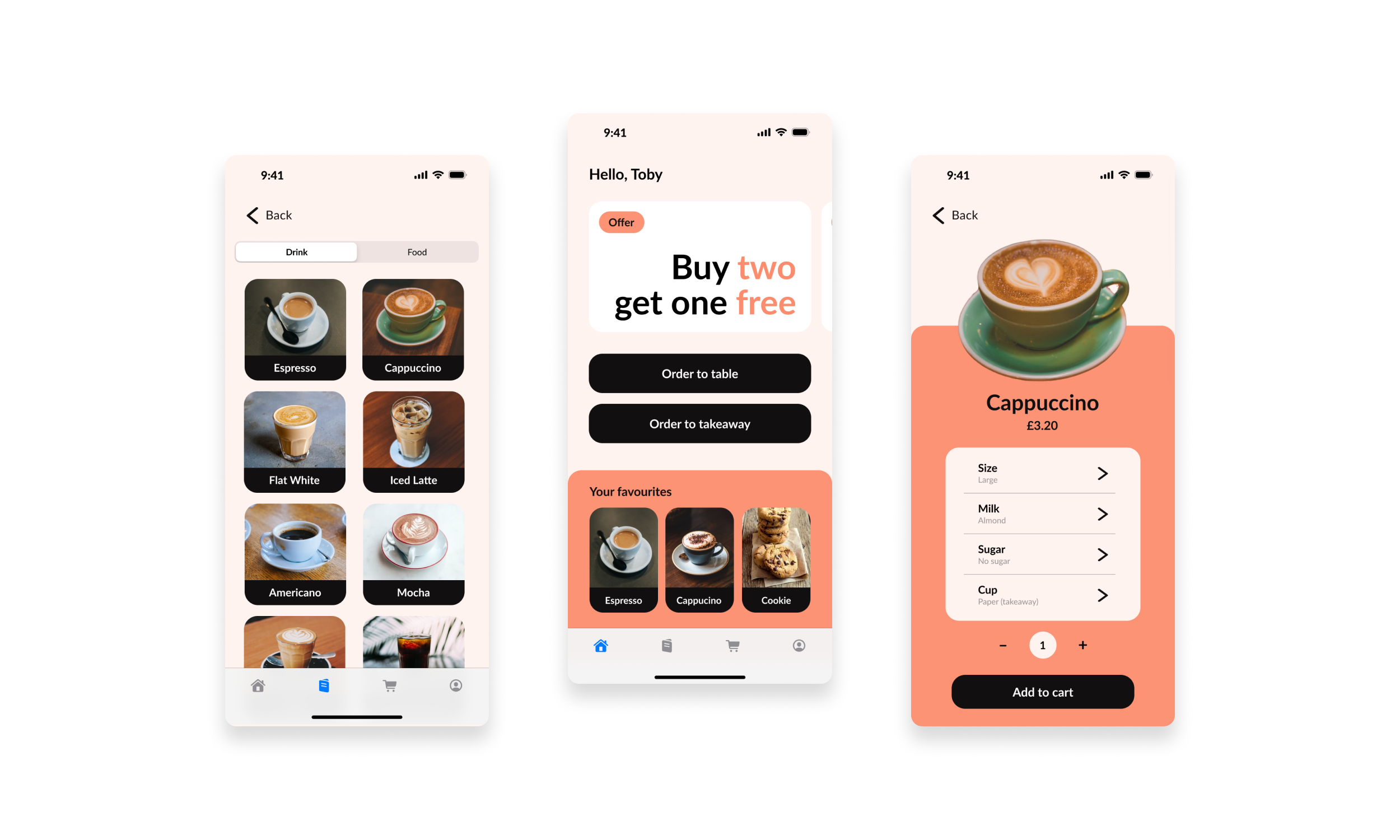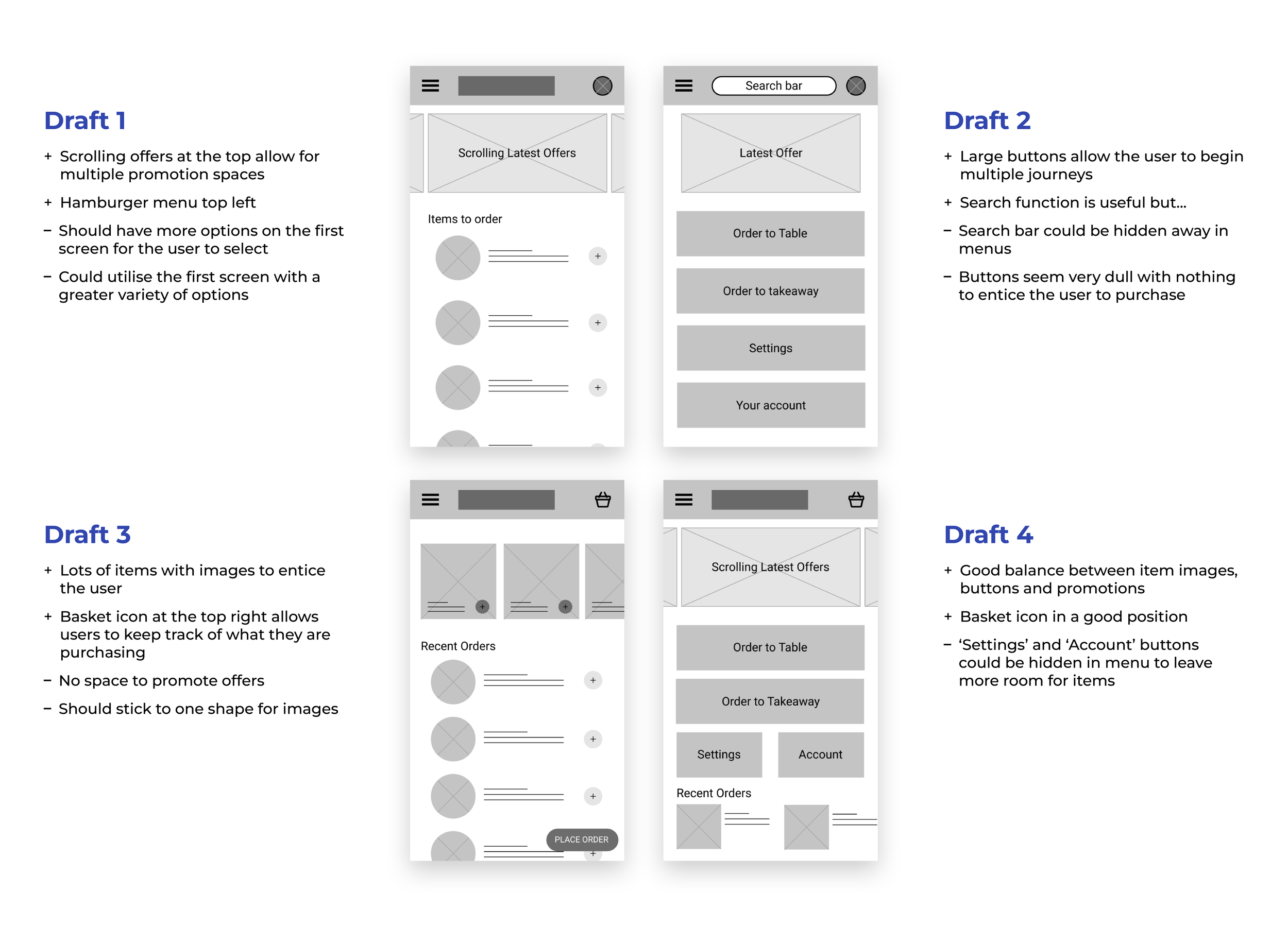
Dream Bag Coffee App
Improving the experience of ordering refreshments while in a coffee shop
When: Nov 2021 - Apr 2022
Role: UX/UI Designer
Platform: iOS/Android
The Problem
It was clear from my user interviews that when working in a coffee shop, people risk losing their spot and/or having their possessions stolen when they go up to a counter to order their refreshments.
The Goal
Design an app that allows users to order refreshments to their table, allowing them to continue to work uninterrupted. This will increase the conceptual coffee shop’s appeal to the ever-growing mobile workforce.
Tools: Miro | Figma | Paper+Pen | Excel | Google Meet
Process: Discover > Define > Develop > Deliver
click on links to jump to section
DISCOVER
Who is my target user and what are their needs?
I started by conducting 1-on-1 interviews with 5 individuals who regularly visit coffee shops to better understand the challenges they face and how I can help solve their problems.
5 people | Ages 25-70 |
Work remotely & retired | Coffee & non-coffee drinkers
Questions
When finding somewhere to work, what do you look for in a coffee shop?
What are some challenges you face in the ordering process?
What are some coffee shops apps you use, and what do you like and dislike about them?
“It’s annoying that I have to put my laptop and stuff away to buy another coffee and get it all out again. By then, I could have lost my spot and plug!”
Key takeaways
Users want a way to order their food/drink to their table
Users can become frustrated by the complicated language used in product descriptions
From my initial user interviews, I found that a growing proportion of the working population works remotely, exclusively out of coffee shops and café. One of the challenges they face is how they have to move away from their seats to order another coffee which was validated by my interviews.
I then conducted a competitive analysis to see if there are any existing products which are trying to address this problem.
For my competitive analysis, I researched other apps in the market to find which features they offered and if they tried to address the problem I found in my interviews. I looked at three direct competitors in the UK coffee chains Caffé Nero, Starbucks, and Costa Coffee and what features their apps offered. I also did an analysis of an indirect competitor who has a similar user base but offers a different product. For this I looked at the co-working space app, WeWork.
From this you can see that they are all very similar in their features with a distinct gap in the problem that I am trying to solve.
Research conclusion
It is clear from my research that these users need a mobile-based solution to help them order coffee to their table while they are working.
DEFINE
What exactly is the problem and who’s affected by it?
Understanding what a day-in-the-life of Eman looks like
With this information, I was able to create a persona that reflects what some of the real users go through in their life. To truly be able to empathise with Eman I mapped what a day of him working in a coffee shop looks like and what his frustrations might be.
Next, I ideated what that journey would look like for Eman if he had the ability to complete his goal with a mobile app. For this, I sketched a zoomed-in user journey with this proposed app.
Captions
Eman is worried about leaving his laptop to go to the counter
Eman finds and opens the coffee shop app
Eman scrolls through the app and finds the items he wants
Eman likes to know how long so he can avoid meetings
Eman places his order for delivery to his table
Eman is happy that his food and drink arrived before his meeting
Prioritising the work: problem statement
Many problem statements came out of my research. I aim to create a solution to solve the biggest user problem I identified from my user research which is underserved by my competitors. The problem is that those who work remotely in a coffee shop do not have a way to order coffee to their table without leaving their items unattended or packing away all their possessions, potentially losing their spot.
I will design it in a way that can scale to solve some of the other problems identified in further iterations of this. I will be taking an MVP approach given the time and resources at hand.
Eman is a freelancer that works remotely and needs a way to order food and drinks to his table because he wants to be able to focus on his work and not have to pack his things away when going up to the counter to order.
DEVELOP
How did I go about solving the problem?
I created some initial sketches based on all my research and validated everything with users through usability tests. Five users tested the low-fi wireframe, completing three prompts while I monitored their journeys over Google Meets.
From the initial wireframes that I critiqued, I then created an interactive lo-fi prototype to conduct my usability tests.
“Would be nice to confirm your card details before paying to make sure that you’re using the correct one” Interviewee during our usability testing.”
80% of participants completed the ordering flow test without any assistance
4 out of 5 users were ‘surprised’ that the journey ended so suddenly without an option to select their preferred payment method. Taking on the feedback from our testing, I included a step to allow users to select their preferred payment method.
Order process before user feedback
Rough sketches for order process solution
Order process incorporating user feedback about card confirmation (step 5)
DELIVER
The Dream Bag Coffee App
After validating all my concepts with users in usability tests, I was confident to keep on moving forward with the next stage. I created a style guide (below) with all the typography and iconography and began applying this to all the screens.
LOOKING AHEAD
Next steps with the Dream Bag Coffee App
Having now produced an MVP (minimum viable product), the next stage is to conduct further research and to continue to refine the designs to ensure they meet the users needs. I also will now start looking at the other pain points that became apparent in my initial interviews and decide which of these to develop. I have listed some of these below and begun to rank them in order of importance.
Working to ensure the names/types of coffee are easy to understand for all types of users
Being able to use your reusable cup when ordering through an app
Loading credit onto your account/sharing this credit with other users
How will we continue to measure success?
Going forward we will continue to measure the success of our product with the following metrics.
Time on task
Conversion rate
Categories explored
This will allow us to monitor and identify where improvements could be made - helping to develop the product and drive the business to succeed.





